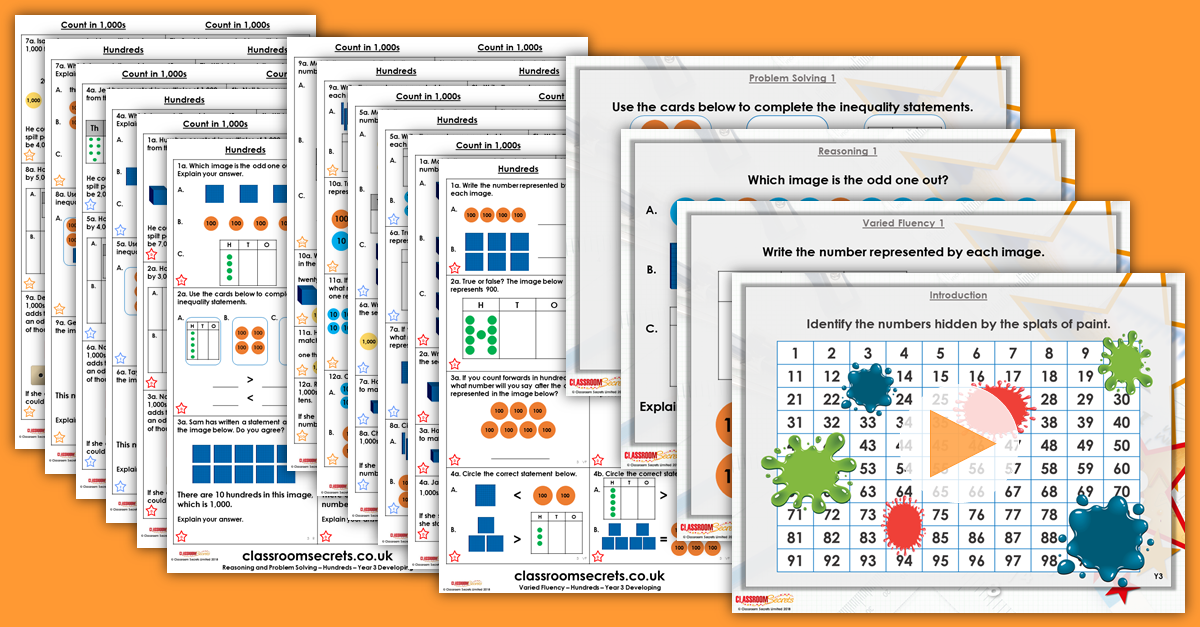Mixed Age Year 3 and 4 Place Value Step 6 Resource Pack

Mixed Age Year 3 and 4 Place Value Step 6
Mixed Age Year 3 and 4 Place Value Step 6 Resource Pack includes a teaching PowerPoint and differentiated varied fluency and reasoning and problem solving resources for both year groups for Autumn Block 1 and covers Year 3 Hundreds & Year 4 Count in 1,000s.
Not a member? Sign up here.
What's included in the Pack?
This Mixed Age Year 3 and 4 Place Value Step 6 pack includes:
- Mixed Age Year 3 and 4 Place Value Step 6 Teaching PowerPoint with examples for both year groups.
- Hundreds Year 3 Varied Fluency with answers.
- Hundreds Year 3 Reasoning and Problem Solving with answers.
- Count in 1,000s Year 4 Varied Fluency with answers.
- Count in 1,000s Year 4 Reasoning and Problem Solving with answers.
National Curriculum Objectives
Mathematics Year 3: (3N1b) Count from 0 in multiples of 4, 8, 50 and 100; find 10 or 100 more or less than a given number
Mathematics Year 3: (3N4) Identify, represent and estimate numbers using different representations
Mathematics Year 4: (4N2b) Find 1000 more or less than a given number
Mathematics Year 4: (4N3a) Recognise the place value of each digit in a four digit number (thousands, hundreds, tens and ones)
Differentiation Year 3 Hundreds:
Varied Fluency
Developing Questions to support identifying, representing and counting multiples of 100. Using a variety of pictorial representations, including place value grids, place value counters and Base 10.
Expected Questions to support identifying, representing and counting multiples of 100. Including some examples of unconventional partitioning. Using a variety of pictorial representations, including place value grids, place value counters and Base 10.
Greater Depth Questions to support identifying, representing and counting multiples of 100. Including unconventional partitioning and using mixed pictorial representations.
Reasoning and Problem Solving
Questions 1, 4 and 7 (Reasoning)
Developing Explain the odd one out from a set of visual representations of multiples of 100, including place value grids, place value counters and Base 10.
Expected Explain the odd one out from a set of visual representations of multiples of 100, including place value grids, place value counters and Base 10 with some unconventional partitioning.
Greater Depth Explain the odd one out from a set of visual representations of multiples of 100, including mixed visual representations, words and unconventional partitioning.
Questions 2, 5 and 8 (Problem Solving)
Developing Use 3 visual representations of multiples of 100 to make an addition and a subtraction number sentence. Using place value grids, place value counters and Base 10.
Expected Use 3 visual representations of multiples of 100 to make an addition and a subtraction number sentence. Using some examples of unconventional partitioning.
Greater Depth Use 3 visual representations of multiples of 100 to make an addition and a subtraction number sentence. Using mixed visual representations, words and unconventional partitioning.
Questions 3, 6 and 9 (Reasoning)
Developing Explain whether a given statement about a visual representation of a multiple of 100 is correct or not. Using place value counters.
Expected Explain whether a given statement about a visual representation of a multiple of 100 is correct or not. Using a place value grid and some unconventional partitioning.
Greater Depth Explain whether a given statement about a visual representation of a multiple of 100 is correct or not. Using mixed visual representations, words and unconventional partitioning.
Differentiation for Year 4 Count in 1,000s:
Varied Fluency
Developing Questions to support identifying, representing and counting forwards and backwards in 1,000s from multiples of 1,000. Using Base 10 only.
Expected Questions to support identifying, representing and counting forwards and backwards in 1,000s from multiples of 1,000. A variety of pictorial representations, numerals and words used.
Greater Depth Questions to support identifying, representing and counting forwards and backwards in 1,000s from multiples of 1,000. Mixed representations within a number, including pictorials, numerals, words and unconventional partitioning
Reasoning and Problem Solving
Questions 1, 4 and 7 (Reasoning)
Developing Explain if a number is possible after counting forwards or backwards in 1,000s from multiples of 1,000. Using Base 10 only.
Expected Explain if a number is possible after counting forwards or backwards in 1000s from multiples of 1,000. A variety of pictorial representations used.
Greater Depth Explain if a number is possible after counting forwards or backwards in 1000s from multiples of 1,000. Mixed representations within a number, including pictorials, numerals, words and unconventional partitioning.
Questions 2, 5 and 8 (Reasoning)
Developing Explain if a number has changed by a given multiple of 1,000. Multiples of 1,000 using Base 10 only.
Expected Explain if a number has changed by a given multiple of 1,000. Multiples of 1,000 using a variety of pictorial representations, numerals and words.
Greater Depth Explain if a number has changed by a given multiple of 1,000. Multiples of 1,000 using mixed representations within a number, including pictorials, numerals, words and unconventional partitioning.
Questions 3, 6 and 9 (Problem Solving)
Developing Find four possible outcomes after adding and subtracting multiples of 1,000. Using Base 10 only.
Expected Find four possible outcomes after adding and subtracting multiples of 1,000. Numbers represented in words.
Greater Depth Find four possible outcomes after adding and subtracting multiples of 1,000. Using numerals, words and unconventional partitioning.
This resource is available to download with a Premium subscription.






